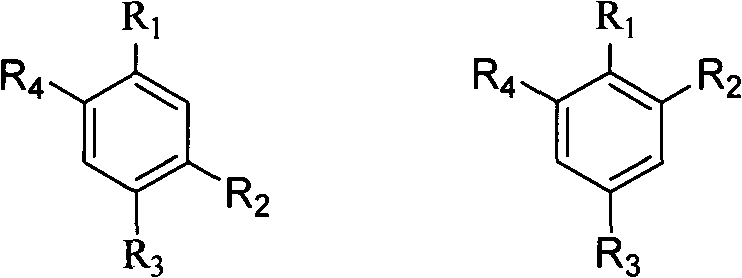Redox couple for lithium ion battery overcharge-resistant mixed additive
A technology of mixing additives and lithium ion batteries, applied in the field of redox pairs, can solve problems such as reducing the overcharge protection performance of redox pairs additives, and achieve the effects of improving long-term cycle stability, improving safe use performance, and reducing permanent damage
- Summary
- Abstract
- Description
- Claims
- Application Information
AI Technical Summary
Problems solved by technology
Method used
Image
Examples
Embodiment 1
[0016] Add 1.50g of p-xylylene dimethyl ether, 3.10ml of tert-butanol and 5ml of glacial acetic acid in sequence in a 125ml Erlenmeyer flask equipped with ice bath and magnetic stirring. After stirring evenly, slowly add 10ml of concentrated sulfuric acid dropwise (5-7min) . After the addition of sulfuric acid is completed, remove the ice bath, continue to stir the whole reaction system at room temperature for 20 minutes until the reaction is complete, add 75ml of ice water, stir for 5 minutes, filter, and use 70ml of ice water and 10ml of ice water solution containing 10% methanol successively for the obtained crystals. After washing, the resulting crystals were recrystallized and purified with methanol aqueous solution, and dried in vacuum to obtain 2,5-di-tert-butyl-p-xylylene dimethyl ether with a yield of about 56.6%.
[0017] In an argon-filled glove box (H 2 O 6 / EC: EMC: DMC = 1: 1: 1 (w / w), two parts were placed in fluorinated bottles, and the first sample was added ...
Embodiment 2
[0019] 2,5-di-tert-butyl-p-phenylene diethyl ether was synthesized by using p-phenylene diethyl ether and tert-butanol as raw materials. The specific method was the same as in Example 1, and the yield was about 38.6%.
[0020] In an argon-filled glove box (H 2 O 6 / EC:EMC:DMC=1:1:1(w / w), then add 2,5-di-tert-butyl-p-phenylenediethyl ether additive to saturation, then add 5wt.% biphenyl, use two kinds of Electrolyte made of LiFePO 4 / / Graphite button battery, charged at 0.2C for 10h (100% overcharge), and then discharged at 0.2C to end voltage 2.0V. The results show that in the first 51 overcharge cycles of the battery, 2,5-di-tert-butyl-p-phenylenediyl ether can effectively clamp the voltage on a voltage platform of about 4.0V, but from the 52nd time onwards, the voltage platform It gradually disappears, and the voltage rises rapidly. At the 54th overcharge, the voltage rises slowly to about 4.5V, until a new voltage platform appears at about 4.7V, and then the battery volta...
Embodiment 3
[0022] Using MCM-41 molecular sieve loaded with scandium trifluoromethanesulfonate as catalyst, phenol / tert-butanol as raw material, supercritical CO at 130 °C 2 Reaction in the system for 6 hours, separation and purification of the product by column chromatography to obtain 2,4,6-tri-tert-butylphenol with a yield of 32.6%, and then to 2,4,6-tri-tert-butylphenol at 2 SO 4 Aqueous solution, then raise the reaction temperature to 80°C, react for 4 hours, the product is separated and purified by column chromatography to obtain 1,3,5-tri-tert-butyl-2-methoxybenzene with a yield of 76.3%.
[0023] In an argon-filled glove box (H 2 O 6 / EC:EMC:DMC=1:1:1(w / w), add 1,3,5-tri-tert-butyl-2-methoxybenzene to its saturation concentration, then add 3wt.% cyclohexylbenzene , using this electrolyte containing mixed additives to make LiFePO 4 / / Graphite button cell. The 100% overcharge test results show that 1,3,5-tri-tert-butyl-2-methoxybenzene can effectively clamp the voltage on the vol...
PUM
 Login to View More
Login to View More Abstract
Description
Claims
Application Information
 Login to View More
Login to View More - R&D
- Intellectual Property
- Life Sciences
- Materials
- Tech Scout
- Unparalleled Data Quality
- Higher Quality Content
- 60% Fewer Hallucinations
Browse by: Latest US Patents, China's latest patents, Technical Efficacy Thesaurus, Application Domain, Technology Topic, Popular Technical Reports.
© 2025 PatSnap. All rights reserved.Legal|Privacy policy|Modern Slavery Act Transparency Statement|Sitemap|About US| Contact US: help@patsnap.com



